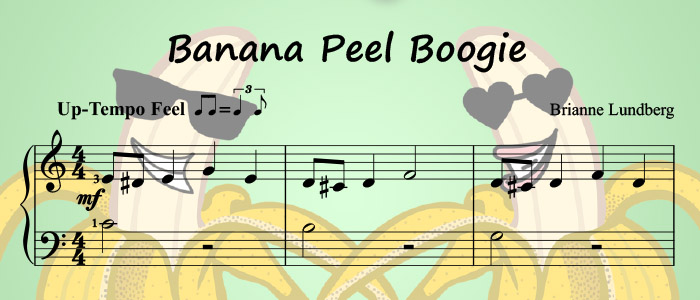Banana Peel Boogie: A Beginner Jazz Piano Solo
Jazz, ragtime, blues, swing -- these musical styles have so much personality and are just so fun to play! But oddly enough, most piano music in these genres is only written for intermediate level and up.
Even though jazz music has many complexities, even the youngest first year student can learn to play it. And why shouldn't they get to play easy jazz piano music? Who knows what some beginner jazz piano sheet music might inspire?
"Banana Peel Boogie" fills this void as an early beginner jazz piano solo, perfect for new beginners who love to swing. It's a contemporary easy jazz piano piece that mixes influences from jazz, ragtime, and swing into the perfect combination for a beginner piano showcase solo.
The Story Behind the Music
A few years back, I discovered that one of my newest beginner piano students had a knack for rhythm. I taught him how to swing one of his pieces and he was instantly hooked, so I decided to write him his very own swingin' piano solo that he could perform as a showcase piece.
For me, there's nothing like a little chromatic action that gets the fingers dancing on the keys. Plus, beginners tend to get pretty excited about playing on both the black keys and the white keys. It was the perfect place to start: quick chromatic eighth notes (E-D#-E) that sidestepped up and down, with simple alternate hand accompaniment so that the pianist could successfully perform it as a standalone piano solo.
As the music took shape, the transitions between chromatic patterns called to mind only one image: a slippery banana peel on the dance floor! "Banana Peel Boogie" was the perfect jazzy title, and it was an instant hit with the student I wrote it for (he mastered it in just one week!).
Teaching Tools in "Banana Peel Boogie" Beginner Jazz Piano Solo
I give all my compositions and arrangements a list of "teaching tools" (educational elements) to help piano teachers and students know what to expect and what they can learn from this piece of music.
"Chromaticism" and "swing" are the most integral teaching tools in this easy jazz piano piece. Every measure has swinging eighth notes on the downbeat so that the swing rhythm isn't overly challenging.
Most measures have sidestepping semitones (half steps), and there are a few partial chromatic scales (1-3-1-3 fingering included). With these chromatic tones there are frequent accidentals, mostly sharp signs with a few flat/natural signs in a descending chromatic phrase. Students who cannot yet read all these symbols fluently can be shown by rote how the patterns are played on piano.
As often heard in ragtime and jazz, "Banana Peel Boogie" has a modulated section. This key change occurs in sound only; the key signature remains blank since the piece is written for beginners. This modulation teaches beginners to recognize when and how key changes occur, and how they shift the feeling of the music.
One or two basic articulations are included for a bit of fun (staccato and accent marks) and give the piece more character.
While it starts in traditional "Middle C Position", required hand movement helps avoid getting "stuck" in a hand position. Even with the hand movement, the entire piece spans only the notes between Bass C and Treble C so that reading it is not too challenging for beginners.
Fingering suggestions are sometimes included but intentionally left off where either there are multiple choices or finger numbers are unnecessary. Examples: measure 1 RH has a finger number only on the first note because fingering for the remaining notes should be intuitive. Next, in measure 2 where RH plays a quick D-C#-D, no fingering is listed because the pianist might choose either a 1-2-1 thumb crossover or move the hand downward to play 3-2-3. It is best to work with a teacher to decide on appropriate fingering.
Lastly, the melody in "Banana Peel Boogie" is shared between hands. The LH is not relegated to accompaniment only but gets the opportunity to play melody and even a partial chromatic scale.
Finally, an Easy Beginner Jazz Piano Solo!
It's true that most jazz piano solos are for intermediate level and up. One possible reason is that many rhythms, harmonies, and various style elements found in jazz are difficult for some beginners to grasp. Thus, traditional method books often don't introduce anything remotely jazzy until at least level 2, and even then it is usually in the form of a duet with all the "real" jazzy bits limited to the teacher part.
As a piano teacher, I think we are selling our students short. Beginner pianists are generally blank slates ready to be taught anything and everything, and some may learn to "swing" even quicker than they learn to recognize C on the staff. Beginner students can be capable of far more than we give them credit!
"Banana Peel Boogie" is an easy beginner jazz piano showcase piece. Having taught it now to multiple beginner students, I can attest that even a motivated first-year student can learn it. And audiences love it! It's one of those pieces that sounds harder than it is, which is a huge motivator for today's piano students.
A full audio preview and page 1 of the sheet music can be viewed on the "Banana Peel Boogie" product page.
For more similar styles, check out current selections from the Rags, Jazz, and Blues sheet music for piano. More jazz piano sheet music coming soon!



